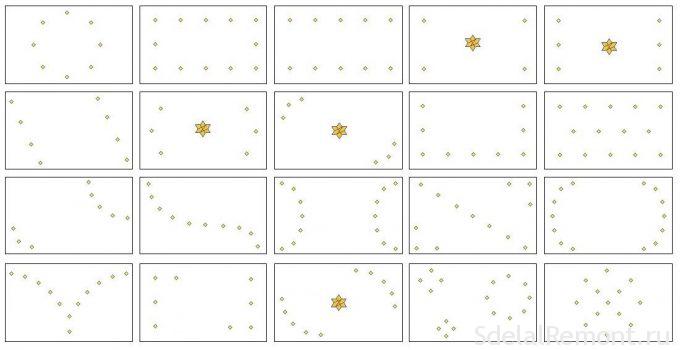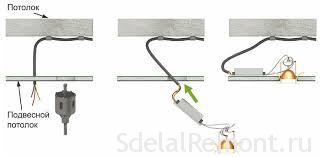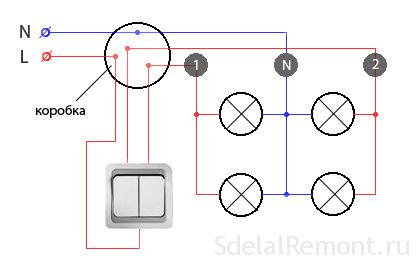Споты, они же точечные светильники – идеальный прибор для установки в подвесные потолочные конструкции, особенно если последние обшиваются гипсокартонными листами. Сама по себе подвесная конструкция уже сокращает высоту потолка в помещении, поэтому монтаж светильников в гипсокартон, которые устанавливаются на уровне подвесной поверхности, дополнительно высоту не уменьшают, а светодиодные модели позволяют произвести установку в маленьких пространствах.
Виды потолочных светильников
Светильники для гипсокартона – это несколько разновидностей, которые друг от друга отличаются типами ламп, потребляемым напряжением и способом установки. Что касается последнего критерия, то здесь две позиции: встраиваемые и накладные.
- встраиваемые – это осветительные приборы, техническая часть которых располагается между гипсокартоном и базовой потолочной поверхностью, а декоративная ниже потолка из ГКЛ;
- накладные устанавливаются по поверхности гипсокартонного потолка, и способ их крепления практически ничем не отличается от установки люстры.
Дополнительно конструктивно светильники для потолков из гипсокартона отличаются еще и по другим качествам:
- одинарные и блочные;
- поворотные и неподвижные.

Касаемо ламп необходимо отметить, что в этих источниках света присутствуют все разновидности осветительных элементов:
- лампы накаливания;
- галогенные;
- светодиодные;
- люминесцентные энергосберегающие.

По потребляемому напряжению светильники делятся в основном на две группы: 220, 24 и 12 В. Установка светильников в гипсокартон (галогенных) на 24 и 12 В требует присутствия понижающего трансформатора, который монтируется в межпотолочном пространстве. Сегодня все больше популярности получают светодиодные светильники.

Требования к установке светильников
Расположение встраиваемых в гипсокартон потолочных светильников на самом потолке никакими правилами и требованиями не ограниченно. То есть, конфигурация может быть самой разной. Но чаще всего приборы располагают так, чтобы освещение в комнате было полным или частичным. Поэтому дизайнеры пользуются тремя схемами:
- Рядами, перпендикулярными стене, на которой располагается окно. При этом расстояние от стены до первого прибора не должно быть меньше 60 см. А шаг установки рядов – 1 м.
- В шахматном порядке. Здесь те же требования.
- Монтаж точечных светильников в гипсокартон производится по периферии. То есть, точечные источники света в данном случае выступают в качестве дополнительного освещения пространства. Основным прибором здесь выступает люстра.
Все три схемы достаточно просты, универсальны, но, как показывает практика, сегодня нередко их не используют. Так как ограничений в схеме расположения точечных светильников нет, то вариаций в этом случае огромное количество. Особенно это относится к потолкам из гипсокартона, сооруженных в два яруса.

Процесс установки точечных светильников
В первую очередь планируется, по какой схеме будет производиться установка. Опытные мастера схему рисуют на бумаге, определяют в масштабе расстояния между приборами и их точное расположение на потолке. Затем отменить крестиками места на потолке где будет расспологаться светильник, это нужно для того чтоб потолок.
Далее производится разводка проводов (кабелей). Этот этап надо проводить после сборки на потолке каркаса из металлических профилей. Хотя некоторые мастера сначала делают проводку, а затем собирают каркас. Но в этом случае придется предварительно определить места монтажа прямых подвесов, нанося на потолочную поверхность метки с учетом расстояния между крепежными элементами. Потому что может случиться так, что провод окажется под местом крепления подвеса. А этого делать никак нельзя.

Есть и вторая сложность проводки для потолочных светильников, встраиваемых в гипсокартон, до монтажа каркаса. Провода (кабеля) придется крепить к базовому потолку. А это дополнительные расходы на крепеж и затраченное время. В то время как прокладка проводов по собранному каркасу – это простое крепление к подвесам при помощи изолированной жилы самого провода в виде скрутки.
В любом случае кабели надо прокладывать, пропустив их через гофрированный монтажный шланг. Это дополнительная защита, увеличивающая срок эксплуатации проводов.
До того как начинать электропроводку, надо на потолке обозначить места расположения светильников.
Схема подключение может быть последовательной или параллельной. В последнем случае параллельных участков может быть несколько в зависимости от того, как будут включаться светильники группами. Это на усмотрение заказчика.
Что касается кабеля (выбора его сечения). Нет надобности рассчитывать этот параметр с учетом потребляемой мощности. Оптимальный вариант – сечение 1,5 мм² ПВС . Лучше приобретать медный мягкий провод. Узнайте лучшие способы соединения многожильный проводов.
Подключение и монтаж светильников
После проведения разводки устанавливают гипсокартонные листы на сооруженный каркас. Затем еще раз, теперь уже на гипсокартонном потолке, обозначаются места расположения осветительных приборов. В них необходимо сделать отверстия под источник света.
Обратите внимание, что еще на стадии формирования схемы распределения светильников по потолочной поверхности необходимо строго учитывать, чтобы осветительный прибор не попал на элемент металлического каркаса. Потому что в таком случае нет возможности провести монтаж, металлический профиль просто будет мешать установке.

Здесь есть один тонкий момент – диаметр точечных светильников для гипсокартона должен совпадать с диаметром отверстия на потолке. Первый параметр производитель обязательно указывает на коробке (упаковке), но лучше его проверить.
Поэтому данный размер наносится на гипсокартонный потолок по местам установки приборов. Для этого лучше использовать циркуль. Теперь надо вырезать отверстия по нанесенной разметке. Есть несколько способов, как это можно сделать:
- Самый простой – просверлить отверстия дрелью, на которую устанавливается коронка диаметром, равным диаметру начерченной на потолке окружности.
- По окружности высверливаются сквозные отверстия мелким сверлом с шагом 1-1,5 см. После чего кусок гипсокартона просто вдавливается внутрь. Правда, кромки отверстия придется доработать острым ножом или лобзиком.
- Можно использовать балеринку. Для этого резак выставляется под радиус отверстия.

Остается только вытащить провода из вырезанных отверстий и подключить к ним светильники.

Способов подключения, а точнее, приспособлений, с помощью которых производится соединение, немало. Самый простой, но и надежный, это клеммники с прижимными винтами или современные клемы WAGO.

Провода от осветительного прибора надо вставить в него с одной стороны, зажимая их винтами, питающую проводку с другой стороны.
Остается только провести установку светильников в гипсокартонный потолок. В конструкции приборов есть специальные зажимные планки (усики), которые подпружинены с одной стороны. То есть, в свободном состоянии они развернуты наружу, соответственно выступают за техническую часть прибора. То есть, разлет усиков больше, чем вырезанный диаметр отверстия на гипсокартонном потолке. Поэтому монтажные планки необходимо прижать, чтобы просунуть их в отверстие.
Иногда это сделать руками непросто, потому что мешает сам гипсокартон. Поэтому опытные мастера поступают так – связывают между собой усики проволокой, а после установки точечного светильника в гипсокартон разрезают ее кусачками или пассатижами. Усики расправляются под действием пружин, опираются на внешнюю сторону потолка, не давая светильнику упасть.

Некоторые конструкции встраиваемых светильников для потолка из гипсокартона являются разборными. То есть, декоративная часть отсоединяется от технической. Поэтому последовательность проведения монтажных работ здесь немного другая:
- Производится разборка прибора.
- Техническую часть устанавливают в гипсокартонный потолок, то есть в отверстие, точно так же, как в вышеописанном случае.
- Производится подключение прибора к питающему кабелю, который вытаскивается через патрон. После чего провод утапливают обратно.
- Декоративную часть присоединяют к технической.
Полезные советы
Несколько рекомендаций, которые помогут избежать ошибок в процессе выбора и установки светильников точечных в гипсокартон.
- Лампы накаливания уже давно не используются в приборах данного типа. Среди остальных видов надо учитывать соотношение оптимальной цены и минимальной мощности потребления электроэнергии. В этом плане энергосберегающие лампы лучше всего. Светодиоды потребляют меньше тока, но такие светильники очень дороги. С галогенными много проблем – требуется трансформатор, часто перегорают.
- Соединение отвода кабеля от основного шлейфа к встроенным светильникам в гипсокартоне производится пайкой. От скрутки лучше отказаться. Можно использовать клеммники типа «орех».
- Проводя электрику, общее питания дома или квартиры надо отключить.
- После подключение, но перед установкой встраиваемых потолочных светильников в гипсокартон необходимо проверить их на рабочее состояние. Просто подается на приборы ток. Если какой-то из них не загорелся, надо найти причину и справить ее.
- Во влажных помещениях монтируются влагозащищенные модели.
- Подбор светильников по мощности выбирается с учетом того, чтобы вся система и потолок не перегревались в идеале это LED светильники
Заключение
При кажущейся сложности монтажа встраиваемых в гипсокартон потолочных светильников, этот процесс осилит даже новичок. Главное – точно следовать последовательности проводимых операций и грамотно подойти к выбору осветительных приборов и их установке. В дополнение посмотрите видео подборку.














